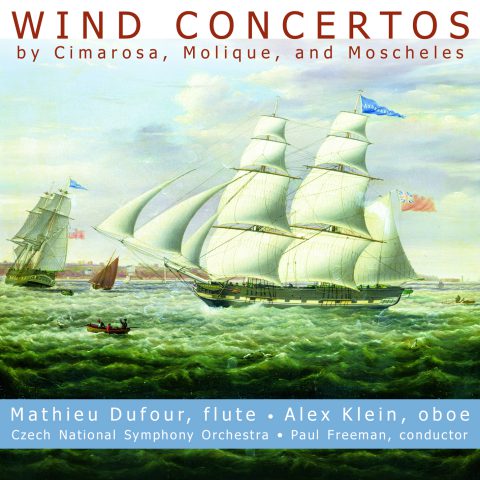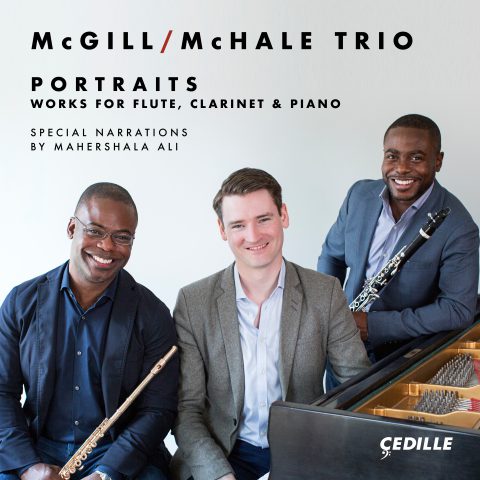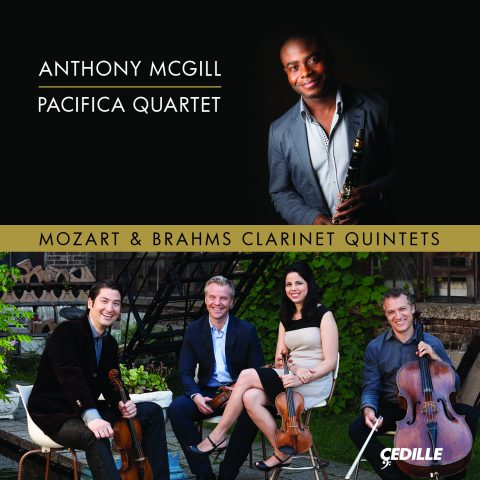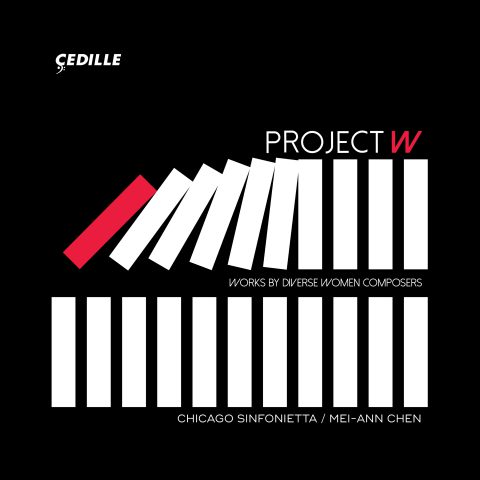Store
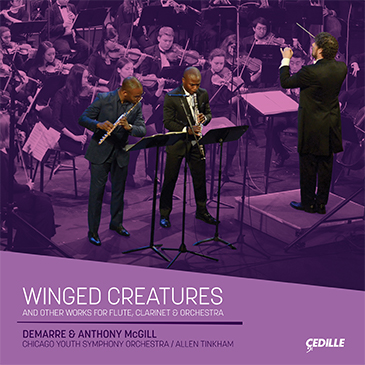
Store
Winged Creatures
Anthony McGill, Demarre McGill, Chicago Youth Symphony Orchestra, Allen Tinkham
Anthony McGill, the New York Philharmonic’s principal clarinetist, and brother Demarre McGill, the Seattle Symphony Orchestra’s principle flutist, return to a beloved training ground, the Chicago Youth Symphony Orchestras (CYSO), for an album of works for flute, clarinet, and orchestra featuring world-premiere recordings of specially commissioned duo concertos.
The album’s title track, celebrated African-American composer Michael Abels’ Winged Creatures, was commissioned for the project by Cedille Records. Inspired by the flight of butterflies and other creatures, its solo parts are, in turns, delicate, frenetic, soaring, and powerful. The orchestra originally commissioned Joel Puckett’s Concerto Duo for a 2012 concert with the McGill brothers. The work evokes family affection and sibling camaraderie. Franz Danzi’s virtuosic and elegant Sinfonia Concertante for Flute, Clarinet, and Orchestra, Op. 41, is a tour de force of late-Classical charm. Saint-Saëns’ youthful, virtuosic Tarantelle, Op. 6, draws inspiration from a southern Italian folk dance. It is something of a signature piece for the McGills, who performed the piano-accompanied version on Mr. Rogers’ Neighborhood when the brothers were 18 and 14, respectively.

Listen to Jim Ginsburg’s interview
with Anthony McGill on Cedille’s
Classical Chicago Podcast
Preview Excerpts
MICHAEL ABELS (b.1962)
FRANZ DANZI (1763-1826)
Sinfonia Concertante for Flute, Clarinet, and Orchestra, Op. 41
CAMILLE SAINT-SAËNS (1835-1921)
JOEL PUCKETT (b.1977)
Concerto Duo
Artists
Program Notes
Download Album BookletWinged Creatures
Notes by Various
MICHAEL ABELS | Winged Creatures
It was a huge treat to create a work for Anthony and Demarre McGill. I wanted to write something that showcased their phenomenal abilities and had the two parts interacting intricately, sharing melodic fragments cooperatively, but also sometimes competing. The music that came to me reminded me of the flight of a butterfly — exciting, graceful, but also uneven and frenetic. This got me thinking about the differing styles of flight among creatures of the air. Some soar, some fly with speed and purpose, some seem random and erratic. So as the piece developed, I tried to depict these contrasts, so the solo parts are at turns, delicate, frenetic, soaring, and powerful. Besides this programmatic writing, the piece also contains a musical acknowledgement that the soloists are alumni of the orchestra accompanying them: the soloists’ melody from the exposition is played by the orchestral winds in the recapitulation while the solo parts soar above them. Perhaps one of today’s orchestra members is tomorrow’s soloist.
FRANZ DANZI | Sinfonia Concertante for Flute, Clarinet, and Orchestra, Op. 41
In the late 18th century, orchestral music performance was undergoing exciting developments. A highly respected center for many innovations was the court orchestra at Mannheim, where the musicians were executing precise dramatic techniques such as the “crescendo,” “rocket,” “sigh,” and other moves that required immense skill (and solid conducting leadership) to keep everyone together as a unit. It was into this exclusive group that Franz Danzi was practically born. His father, Innocenz Danzi, joined the Mannheim orchestra as a cellist when he was only 24-years-old and rapidly became one of the top musicians in town — and also one of the highest paid. Franz would become a member of the orchestra in 1778 at the age of 15, joining his older brother, Johann Baptist, a violinist who had won a permanent post there in 1777.
Franz Danzi would continue to be active as a cellist through 1798, during which time he had relocated to Munich and became increasingly focused on composition, culminating with an appointment as Vice-Kapellmeister. He would stay in Munich until 1807 when opportunity took him to Stuttgart. It was here that Danzi would meet Carl Maria von Weber, who remained a lifelong friend, and would take over the leadership of a new “institute for music” founded by the King of Württemberg, where Danzi was also in charge of the woodwinds. Although a cellist, it is clear from listening to the Sinfonia Concertante (likely written between 1807 and 1813) that Danzi had a flare for realizing the virtuosic and elegant potential of the clarinet and flute. Somewhere between a concerto and a symphony, the Sinfonia Concertante is a tour de force of classical charm.
CAMILLE SAINT-SAËNS | Tarantelle, op. 6
Saint-Saëns spent his career supporting and encouraging his fellow French composers, including a young and up-and-coming Claude Debussy. While his protégés pursued increasingly eclectic paths, integrating new pentatonic tonalities and dreamy, Symbolist language, Saint-Saëns turned toward the past, the music of the Baroque and Renaissance, for new inspiration. Although criticized for this tendency to look backward, Saint-Saëns was unflustered by critiques. He responded by saying, “Music is something besides a source of sensuous pleasure and keen emotion…. He who does not get absolute pleasure from a simple series of well-constructed chords, beautiful only in their arrangement, is not really fond of music.”
A delightful example of enjoyable simplicity from early in his career is Saint-Saëns’ Tarantelle, written in 1857 when the composer was only 22-years-old. By that time, he had already spent some years in the celebrated position of a young star on the Parisian classical scene, both as a composer and as an organist. He was appointed organist at Saint-Merri in 1853 and then at La Madeleine four years later, where Franz Liszt called him the “greatest organist in the world.” Right before he left his post at Saint-Merri, Abbé Gabriel invited Saint-Saëns to travel with him to Southern Italy. It was after this trip Saint-Saëns wrote his Tarantelle, a folk dance originating from that region. Legend has it the dance was meant as an antidote to a spider bite, but more likely it was simply a mix up: the town of Taranto was the namesake of both the dance (tarantelle, for courtship) and the spider (tarantula).
JOEL PUCKETT | Concerto Duo
As I began work on this concerto for the brilliant brothers Anthony and Demarre McGill, my thoughts turned to family and childhood. To shared experiences and the joy of sibling camaraderie. Although the entire piece is dedicated to the brothers, the individual movements take their inspiration from, and their dedications are given to, three very special toddlers.
The first movement carries the title, “Great American Scream Machine.” Growing up in Atlanta, my folks used to take my sister and me to Six Flags every summer. That amusement park features one of the world’s largest wooden rollercoasters, the Great American Scream Machine. Needless to say, this thing terrified me (and does to this day). This movement is dedicated to Roya McAllister, whose parents are my dear friends, Roshanne Etezady and Timothy McAllister. In December, Roshanne and Tim welcomed their daughter Roya to the world. I created this movement as tribute to her.
If you have ever tried to put a toddler down for a nap, you will understand the sentiments behind the second movement. The image of the soft lullaby gently and smoothly soothing children to sleep seems ridiculous in the face of my nightly reality! My daughter (this movement’s dedicatee) fights sleep like a heavyweight prizefighter. Our nighttime routine has become set in stone. I give her a bath, put her in her pajamas, and we read a book or two. And then we come to my favorite portion of the routine: the lullabies. By far, her favorite lullaby is the one my grandmother, MamaDee, used to sing to me: “Sail Far Away, Sail Across the Sea, Only don’t forget to Sail, back again to me.” At least, I thought it was the one MamaDee used to sing to me. I got curious about the rest of the verses and found that the song was written in 1898 by Alice Riley and Jesse Gaynor and has only a passing resemblance to the song I remember MamaDee singing to me. Better yet, it has virtually no resemblance to the lullaby I had been singing to my daughter!
Following an extended introduction of the lullaby material by the soloists, you will hear them take turns trying to coax the toddler to sleep only to be interrupted by the little stomps of a very tired and stubborn (but very cute) little girl. Approximately two thirds of the way through the movement a dramatic change occurs where all involved (daddy and daughter) begin to succumb to sleep. As the haze overtakes daddy and daughter, the lullaby appears in four-part canon, with half the orchestra singing and half the orchestra playing the lullaby then slowly dissolving into a sleepy A-flat major chord sung by the entire orchestra.
The soloists emerge from this singing to begin the third movement by passing arpeggios back and forth, slowly picking up more and more steam and launching into sounds that are reminiscent of the cool breezes and sunshine of Southern California, which is the birthplace of Audrey Simonds’s father. This movement is dedicated to the daughter of CYSO former Executive Director and General Manager, Joshua Simonds, who was a sounding board and source of constant support throughout my time as CYSO’s composer-in-residence.
Concerto Duo is dedicated to the amazing brothers, Anthony and Demarre McGill and their parents. They are all an inspiration and fantastic models for how to live as an artist and, more importantly, as a human. I am humbled and grateful to have them turn their attention to my notes.— Joel Puckett
ANTHONY MCGILL, CLARINET
Clarinetist Anthony McGill is one of classical music’s most recognizable and brilliantly multifaceted figures. He serves as the principal clarinet of the New York Philharmonic, that orchestra’s first African-American principal player. Hailed for his “trademark brilliance, penetrating sound and rich character” (The New York Times), as well as for his “exquisite combination of technical refinement and expressive radiance” (The Baltimore Sun), McGill also serves as an ardent advocate for helping music education reach underserved communities. McGill was honored to take part in the inauguration of President Obama, premiering a piece by John Williams alongside violinist Itzhak Perlman, cellist Yo-Yo Ma, and pianist Gabriela Montero.
McGill appears regularly as a soloist with top orchestras around North America including the New York Philharmonic, Metropolitan Opera, Baltimore Symphony, San Diego Symphony, and Kansas City Symphony, and is a favorite collaborator of the Brentano, Daedalus, Guarneri, JACK, Miró, Pacifica, Shanghai, Takacs, and Tokyo Quartets, as well as Emanuel Ax, Inon Barnatan, Yefim Bronfman, Gil Shaham, Midori, Mitsuko Uchida, and Lang Lang.
A graduate of the Curtis Institute, McGill previously served as the principal clarinet of the Metropolitan Opera. He serves on the faculty of the Juilliard School, the Curtis Institute of Music, Bard College’s Conservatory of Music, and the Manhattan School of Music.
DEMARRE MCGILL, FLUTE
Demarre McGill is a leading soloist, recitalist, and chamber and orchestral musician. Winner of an Avery Fisher Career Grant, he has appeared as soloist with the Philadelphia Orchestra, and the Chicago, Seattle, Pittsburgh, Dallas, San Diego, and Baltimore Symphonies. In 2018, he performed and presented masterclasses in South Africa, South Korea, and Japan, soloed with the New York Youth Symphony at Carnegie Hall, and performed with the Cathedral Choral Society at the National Cathedral in Washington DC in a program titled “Bernstein the Humanitarian.”
Now principal flute of the Seattle Symphony, Demarre previously served as principal flute of the Dallas Symphony and San Diego Symphonies, Florida Orchestra, and Santa Fe Opera Orchestra. He also recently served as acting principal flute of the Metropolitan Opera Orchestra and earlier with the Pittsburgh Symphony Orchestra.
A founding member of The Myriad Trio, and former member of Chamber Music Society Two, Demarre has participated in the Aspen, Santa Fe, Marlboro, Seattle, and Stellenbosch chamber music festivals, to name a few. He is the co-founder of The Art of Élan and, along with clarinetist Anthony McGill and pianist Michael McHale, founded the McGill/McHale Trio in 2014.
Demarre McGill received his Bachelor’s degree from The Curtis Institute of Music and Master’s degree from The Juilliard School. He currently serves as Visiting Assistant Professor of Flute at Cincinnati College-Conservatory of Music.
CHICAGO YOUTH SYMPHONY ORCHESTRAS
The Chicago Youth Symphony Orchestras is investing in the future of music and the next generation of leaders. CYSO provides music education to more than 650 young musicians ages 6–18 through full and string orchestras, jazz, steelpan, chamber music, masterclasses, and music composition. Students learn from Chicago’s most respected professional musicians, perform in the world’s great concert halls, and gain skills necessary for a successful future.
CYSO Community Partnership Programs support music training and access for more than 8,500 young people each year. The organization works with youth in diverse Chicago neighborhoods through after-school ensembles and the Ambassadors Program, which brings student musicians into CPS elementary schools to perform interactive concerts. CYSO orchestras also present free community and education concerts throughout the season.
CYSO alumni go on to play in the world’s finest orchestras and ensembles, and are also found working as doctors, lawyers, teachers, community leaders, and business professionals. Whether or not a graduate continues music studies after his or her time in CYSO, young people leave with increased self-confidence, a strong sense of discipline, and a deep appreciation for music and the arts.
The CYSO would like to specially thank Steven Gooden.
CYSO SYMPHONY ORCHESTRA
Internationally recognized as one of the world’s foremost youth orchestras, the CYSO Symphony Orchestra is comprised of the organization’s most talented and dedicated student musicians. Under the direction of Music Director Allen Tinkham, Symphony Orchestra students have the opportunity to hone their skills while performing the most advanced orchestral repertoire alongside exciting new works by contemporary composers. The CYSO Symphony Orchestra’s annual seasons feature collaborations with leading cultural institutions, a concerto competition, and performances at Chicago Symphony Center’s Orchestra Hall and Millennium Park’s Jay Pritzker Pavillion.
Since its first season in 1946, the CYSO Symphony Orchestra has achieved international recognition for its excellence and innovation in orchestral performance. The orchestra is known as an important training ground for the cultivation of the next generation of professional musicians, with alumni playing in more than 40 orchestras around the world including the Chicago Symphony Orchestra, New York Philharmonic, Los Angeles Philharmonic, Cleveland Orchestra and the Royal Concertgebouw Orchestra in Amsterdam, among many others.
Notable alumni of the CYSO Symphony Orchestra include Cedille recording artists Demarre and Anthony McGill and violinist Rachel Barton Pine, American indie-rock star Andrew Bird, performance artist Laurie Anderson, Royal Danish Orchestra concertmaster Emma Steele, Cleveland Orchestra principal oboist Frank Rosenwein, Boston Symphony Orchestra assistant principal cellist Martha Babcock, and Berlin Philharmonic violist Allan Nilles, to name a few.
The Symphony Orchestra is a leader in the performance of contemporary orchestral music among youth. Among its honors are 11 ASCAP awards for adventurous programming; three Illinois Council of Orchestras Youth Orchestra of the Year awards; two Illinois Council of Orchestras Programming of the Year awards; broadcasts on National Public Radio and WFMT; and international tours to the music capitals of Central and Western Europe, Asia, and South America.
ALLEN TINKHAM, ARTISTIC DIRECTOR
Allen Tinkham is increasingly recognized as one of the most inspiring conductors and teachers of his generation. The Chicago Tribune hailed Tinkham as working “wonders” and conducting with “uncanny control,”and described him as one of Chicago’s most important “educators, mentors and inspirational guides in the training of tomorrow’s orchestral professionals.”
As CYSO Music Director, Tinkham oversees artistic programming and faculty and leads the CYSO Symphony Orchestra each season, including appearances at Orchestra Hall in Chicago’s Symphony Center and Millennium Park’s Pritzker Pavilion. The Chicago Tribune described a 2018 performance of Varèse’s Amériques — the first ever by an American youth orchestra — as one that “would have done credit to an adult professional orchestra.”
An advocate of contemporary music, Tinkham has won nine ASCAP National Awards for Adventurous Programming of Contemporary Music. He is also Music Director of the Chicago Composers Orchestra and a core faculty member of Columbia College’s MFA, Music Composition for the Screen. Tinkham has led festival orchestras throughout the nation, including the NAfME All‐Eastern and All‐Northwest, and has guest conducted with the Chicago Symphony Orchestra, Colorado Symphony, and Kansas City Symphony.
Tinkham began his career as Apprentice Conductor of the Oregon Symphony under James DePreist. Before the end of his apprenticeship, Tinkham was appointed Music Director of CYSO, making him the youngest-ever to win the post in its history.
Album Details
Producer James Ginsburg
Engineer Bill Maylone
Steinway Piano Technician Ken Orgel
Graphic Design Bark Design
Recorded June 16–17, 2018 at Studebaker Theater, Chicago, IL
PUBLISHERS
Winged Creatures © 2018 Subito Music Publishing (ASCAP)
Concerto Duo © 2012 Joel Puckett Music
© 2019 Cedille Records
CDR 90000 187
